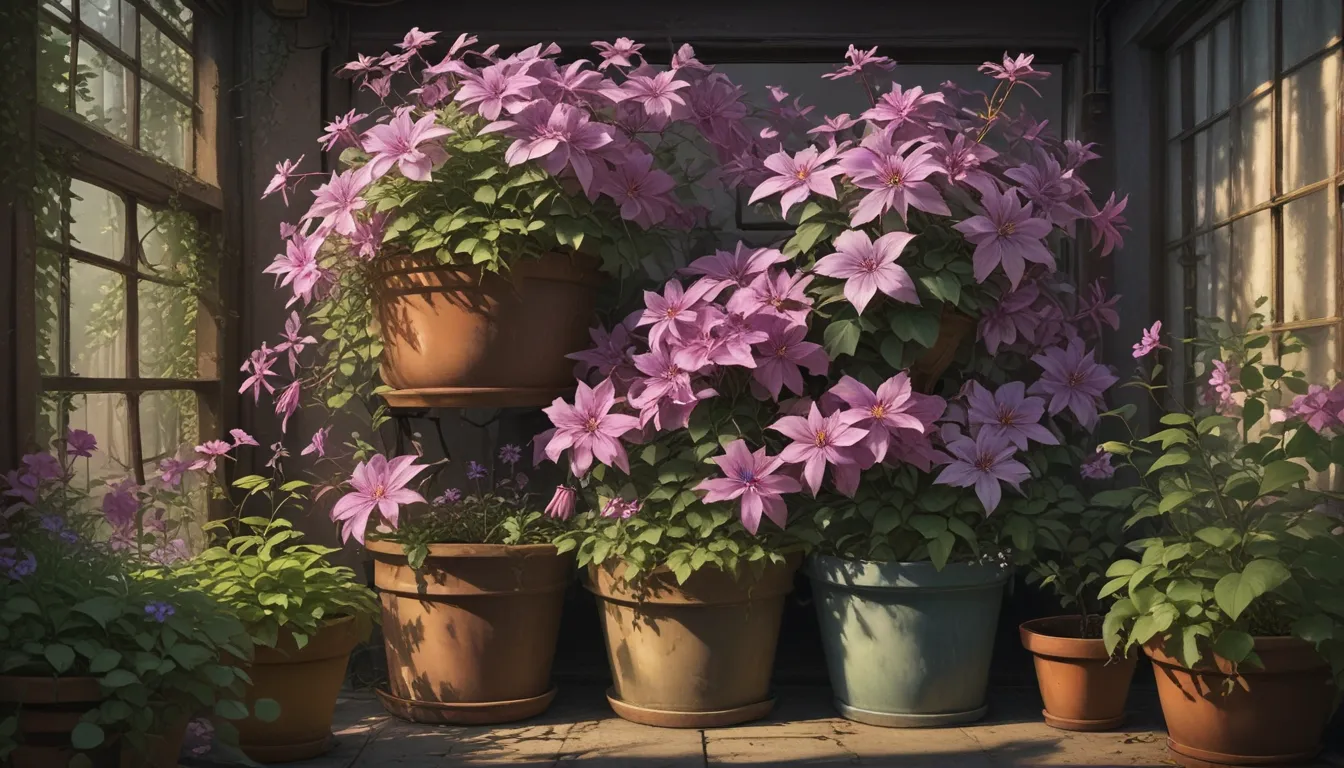How to Grow Stunning Clematis in Containers: Tips and Tricks for Success

Are you looking to add a pop of color and beauty to your outdoor space with minimal effort? Consider growing clematis in containers! This perennial, flowering vine is not only super hardy, but it also offers large, spectacular blooms in a rainbow of colors that last from the last frost to the first frost. This article aims to guide you through the process of growing clematis in containers, providing you with valuable information and tips for success.
Why Choose Container Growing?
Container growing offers several advantages that make it an attractive option for gardeners. Here are some reasons why you might want to consider growing clematis in a container:
-
Mobility: If you are renting a property or prefer the flexibility to move your plants around, container-grown clematis is the way to go. You can easily move your plant to a new location or protect it from extreme weather conditions.
-
Easy Containment: Container growing helps keep the vine’s roots neatly contained, preventing them from spreading into the ground unchecked.
-
Watering: Container plants are easier to water, especially during droughts when water may be scarce. You can maintain the soil moisture levels more effectively in a container compared to in-ground plants.
-
Soil Refreshment: Container growing allows you to refresh the soil periodically, providing a clean environment for your plant. This can be beneficial in preventing soilborne diseases or infestations.
Which Container Is Best?
Choosing the right container is crucial for the successful growth of clematis. Here are some tips for selecting the best container:
-
Size: The container should be approximately three to four inches wider than the root system to begin. As the plant grows, you may need to repot it into a larger container.
-
Material: Clay pots with good drainage are ideal for clematis, as they allow for proper transpiration. Avoid using plastic or resin pots, as they can retain excess moisture.
-
Moisture: Ensure that the container has adequate drainage holes to prevent waterlogging, which can lead to root rot.
How to Prepare Your Container
Proper preparation of the container is essential for the successful growth of your clematis. Here’s how to prepare your container:
-
Sanitization: If you are reusing a pot, sanitize it with a solution of nine parts water to one part household bleach. Rinse thoroughly and allow it to dry.
-
Potting Mix: Choose a potting mix rich in organic matter, such as two parts soil, one part compost or aged manure, and one part perlite or coarse sand for aeration and drainage.
-
Planting: Carefully plant your clematis in the prepared container, ensuring that the roots are positioned below the surface level.
How to Grow
Growing clematis in containers requires proper care and attention to ensure healthy growth. Here are some tips for growing clematis in containers:
-
Plant Selection: Choose healthy, robust plants from nurseries or garden centers. Look for signs of disease or infestation and avoid transplanting while plants are in bloom.
-
Planting: Soak bare roots in warm water before planting, and ensure that the roots are positioned properly in the soil.
-
Location: Place your container in a spot that receives full sun for at least six hours per day. Provide shade to keep the roots cool and moist.
-
Watering: Monitor soil moisture levels, watering as needed to keep the soil moist but not waterlogged. Ensure proper drainage to prevent root rot.
Growing Tips
Here are some additional tips for growing clematis in containers:
- Choose a container that is at least 18 inches deep and 12 inches wide, repotting as needed.
- Provide six to eight hours of full sun per day, while keeping the roots cool and shaded.
- Keep the soil moist but not wet, checking moisture levels daily and watering as needed.
- Repot every two to three years to refresh the soil and prevent root constriction.
Pruning and Maintenance
Proper pruning and maintenance are crucial for the health and vigor of your clematis plant. Here’s how to care for your container-grown clematis:
-
Pruning: Avoid pruning at the base of the vine to allow it to fill in and create a canopy. Prune according to the variety, with some requiring minimal pruning and others needing more attention.
-
Winterizing: Provide protection for your plant during harsh winter weather, especially for potted plants with less insulation. Watering, wrapping, and mulching are essential for winter care.
-
Repotting: Eventually, you’ll need to repot your clematis to allow for optimal growth. Ensure proper root health and soil preparation when repotting.
Cultivars to Select
There are numerous clematis varieties to choose from, but some are better suited for container growing. Here are a few cultivars that might make a nice addition to your space:
- Blue Light: A cold-hardy variety with incredible blue-violet blooms.
- Pink Fantasy: A compact plant with pale pink flowers, perfect for containers.
- Guernsey Cream: A vigorous bloomer with creamy blossoms, ideal for Zones 4 to 9.
Managing Pests and Disease
While clematis vines are fairly robust, they can still be susceptible to pests and diseases. Here are some tips for managing common issues:
- Pests: Watch out for aphids, scale insects, caterpillars, and thrips. Slugs and snails may also be problematic.
- Diseases: Powdery mildew, clematis slime flux, and wilt can affect your plant. Water at the soil level and maintain proper airflow to prevent disease.
With proper care and attention, your clematis vine can thrive in a container, adding beauty and charm to your outdoor space. Experiment with different varieties to find the perfect match for your environment and enjoy the stunning blooms throughout the growing season.
We’d love to hear about your experiences with growing clematis in containers in the comments below. Share your tips, tricks, and success stories with us!
For more information on clematis varieties and care tips, check out these recommended articles:
- 13 of the Best Spring-Flowering Clematis Varieties
- The 27 Best Cold-Hardy Clematis Varieties
- 19 of the Best Summer-Flowering Clematis for Your Garden
- 17 of the Best Fall-Blooming Clematis Varieties
Happy gardening!





